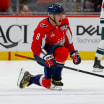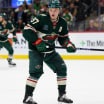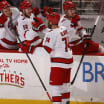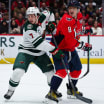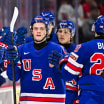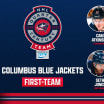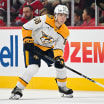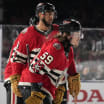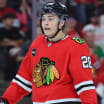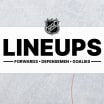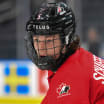Legendary hockey reporter and analyst Stan Fischler writes a weekly scrapbook for NHL.com. Fischler, known as "The Hockey Maven," shares his knowledge, humor and insight with readers each Wednesday.
Today, he looks at one of the biggest trades in NHL history, a nine-player exchange between the Detroit Red Wings and Chicago Black Hawks in July 1950.
Nine-player trade between Red Wings, Black Hawks rocked NHL in 1950
Detroit acquired two key pieces of future Cup-winning teams from Chicago
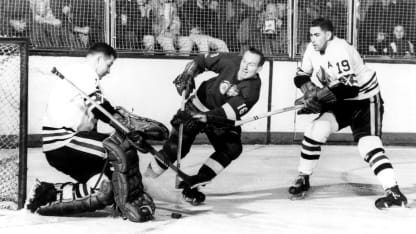
© Bruce Bennett/Getty Images
By
Stan Fischler
Special to NHL.com
Nine-player trades aren't unheard of in the NHL. But they are rare.
That helps to explain why the trade between the Detroit Red Wings and Chicago Black Hawks (it was two words back then) on July 13, 1950, was extraordinary on so many counts.
For one thing, Red Wings general manager Jack Adams broke up part of the core of his 1950 Stanley Cup champions. He did it position by position, from goalie out, to consummate the trade with his Chicago counterpart, Bill Tobin.
Out went future Hall of Fame goalie
Harry Lumley
, who had taken Detroit to the Cup Final four times since 1945 and won it in 1950.
Out went future Hall of Fame defenseman
Jack Stewart
, one of the hardest hitters in NHL history.
Out went forward
Pete Babando
, who had scored the Cup-winning goal in double overtime of Game 7 less than three months earlier.
Out went two promising young players -- defenseman
Al Dewsbury
, who played 11 regular-season games and four more in the playoffs for the 1949-50 Red Wings, and forward
Don Morrison
, who had skated for Detroit in 1947-48 and 1948-49 before spending the 1949-50 season in the minors.
There was plenty of head-shaking in Detroit because the return didn't seem all that impressive at the time.
In exchange for Lumley, who went on to become a two-time NHL First-Team All-Star (though not in Chicago), Detroit received goalie
Jim Henry
, who was having trouble hanging on to an NHL job (remember, there were only six of these at the time).
To replace the intimidating Stewart, the Red Wings acquired
Bob Goldham
, a defenseman who previously had failed to fulfill his potential with the Toronto Maple Leafs and the Black Hawks.
In the biography, "Bob Goldham -- Outside the Goal Crease," by Jim Amodeo, Goldham revealed how stunned he was when he was told he'd been traded.
"The pressure came from me being the guy who was to replace Jack Stewart," he said. "He had been one of the premier NHL defensemen, and I was meant to take his place."
Adams' other two forward acquisitions were a mixed bag.
Gaye Stewart
, who won the Calder Trophy, voted to the NHL's top rookie, with the Maple Leafs in 1942-43 and led the League with 37 goals in 1945-46, was 27 and fading as a scorer; he played one season with Detroit before being sent to the New York Rangers. However,
Metro Prystai
was a 22-year-old whose star was ascending; he wound up providing valuable secondary scoring behind the "Production Line" of
Ted Lindsay
,
Sid Abel
and
Gordie Howe
.
Apart from the fact that nine-player deals just didn't happen, the timing was also astonishing: It came without notice while most NHL personnel were more occupied with vacations than hockey.
"The year 1950 will long be remembered as the year when the usual summer hockey silence was broken with a BANG," Blackhawks beat writer Bud Booth wrote in The Hockey News.
Once renowned for his startling deals, Adams was being questioned by the critics. What was he thinking? That was the main theme among the media. Had Jack simply lost his touch? At first it appeared that Chicago had won the trade.
"With Lumley in the nets and Stewart on defense at least a third of each game, the Hawks may finally have a combination capable of lifting them out of the cellar and into the playoffs," Booth wrote.
But history would show that Adams knew exactly what he was doing and would come out on top
For starters, the acquisition of Henry was small potatoes. He spent the 1950-51 season in the minors before being traded to the Boston Bruins, where he became a full-time NHL starter.
What Adams knew was that Lumley, as good as he was, had become disposable because of a hot prospect on Detroit's farm team in Indianapolis.
Terry Sawchuk
, a kid from Winnipeg, easily made the Red Wings out of training camp in the fall of 1950 and went on to win the Calder Trophy after leading the NHL with 44 victories in his rookie season. In contrast, Lumley had a forgettable season with Chicago; he allowed 245 goals and finished with a 3.90 goals-against average for a last-place team.
Adams also came out ahead on defense. He realized that Stewart had an ailing back that soon would end his career. Meanwhile, Goldham suddenly emerged as one of the NHL's outstanding defensemen, a near Hall of Famer. Many historians credit him with developing and perfecting the shot-blocking technique so prevalent in today's game.
"Bob was the first guy to start blocking shots," Hall of Fame goalie
Glenn Hall
said, "and he made it into an art form."
Goldham fit in perfectly.
"My first year with Detroit was memorable in many respects," Goldham recalled. "From that moment on, my greatest time in hockey began."
Likewise, Prystai was a valuable contributor on the Red Wings' Stanley Cup championship teams in 1952 and 1954.
As for Chicago, Tobin got quantity -- but quality was another story. Neither Lumley nor Stewart made an impact, and Babando's scoring magic disappeared.
Then there was the curious case of Morrison, regarded as a diamond in the rough. He eventually became rich -- but not with the Black Hawks. He and hockey-playing brother Rod Morrison quit the game two years later and became very successful house-builders in Omaha, Nebraska.
The most useful piece was Dewsbury, who proved valuable in 1952-53 when Chicago made the playoffs for the first time since 1946.
Lumley eventually wound up in Toronto and regained the form that had helped Detroit win the Cup in 1950. Henry became Boston's starter in 1951-52 and played every game in each of the next three seasons.
All things considered, the acquisition of Goldham was enough for Detroit to win this rare mega-deal.
"From that moment on, my greatest time in hockey began," Goldham said of being traded to the Red Wings. Lindsay said Goldham, "was the best defensive defenseman to play in front of a goalie."
Emile Francis
, a goalie who was Goldham's teammate in Chicago, supported Lindsay's point.
"Bob was the best defensive defenseman I ever played for," he said.
This was Tobin's second big deal in less than three years while running the underfinanced Black Hawks. In November 1947, he traded Hall of Fame center
Max Bentley
to Toronto for five players: Stewart,
Gus Bodnar
,
Bud Poile
,
Ernie Dickens
and Goldham.
By the time Chicago ended its playoff drought in 1953, only Bodnar remained. Meanwhile, Bentley helped Toronto win Stanley Cup championships in 1948, 1949 and 1951.
The big trade with the Red Wings couldn't keep Chicago from finishing last in the six-team NHL for the fourth time in five seasons. The Black Hawks finished last again in 1951-52, then followed their return to the playoffs in 1952-53 with four more last-place finishes. Not until 1958-59, after a change of ownership and the revitalization of its farm system did Chicago find its way back to the playoffs
